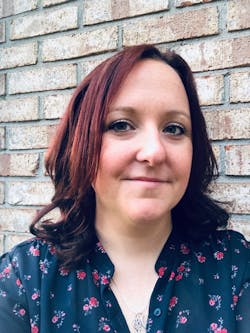It’s a surprise to hear from an EHS professional that a fall could be a good thing.
A stumble into an environmental science class during college inspired Amy Staley, Hitachi Cable America’s division environmental and safety manager, to pursue a career in safety.
In 2002, Staley entered Eastern Kentucky University’s forensics program. A chemistry course during her first semester proved lackluster, and she saw her interest in the field quickly diminish.
On a whim, Staley instead began taking an environmental science class which discussed wastewater, vector-borne illnesses, industrial hygiene and soil contamination.
This eventually led to a degree in environmental health science and her first foray into the safety field as a trainer at JBS Swift and Company in Louisville, Ky.
“Prior to this position, I did not have 'real-world' experience in the EHS field and frankly, I had no idea what I was doing!” she exclaims. “At this position, I trained employees in OSHA required topics including lockout tagout, confined space, hot work, fall protection, electrical safety, and hazard communication. Through developing and implementing training presentations, conducting audits, and job safety analyses, I fell in love with the EHS field.”
Onwards and Upwards
After working several years at JBS, Staley received a scholarship to attend the University of Cincinnati, achieving a master’s degree in industrial hygiene.
Shortly after graduation, she became an EHS specialist for Siemens Rail in Louisville, KY and eventually arrived at Hitachi Cable America Inc., where Staley currently makes waves leading safety initiatives at the company’s automotive products division.
Staley’s vertical movement up the EHS career ladder was not without obstacles. One of her biggest challenges was being heard in a field where women comprise only 18% of safety professionals. This, however, did not stop her from pushing forward.
“As a woman, my challenge has been acceptance into the manufacturing world, which historically has been male-dominated,” she explains. “Throughout my career, I have learned that to perform my job functions adequately, and to gain the respect of colleagues, not only do I need to understand EHS regulations, I also need to understand the production processes, how equipment operates, and the challenges faced by the engineering and maintenance departments.”
Once she understood what challenges other departments faced, Staley was able to gain respect with her colleagues and work together to find viable solutions to EHS concerns.
Career Advice
The EHS field continually faces an evolution as new hazards pop up and regulatory standards change. This, Staley says, is what will keep the profession valuable and essential in the future.
“As technology improves and manufacturing expands, the need to protect human health and the environment continues to grow,” she says. “More professionals who are passionate about the safety of workers and preserving the environment are needed.”
Ongoing change also means new duties and opportunities, which keeps the profession fresh and exciting.
“I can say with confidence that the EHS field is never boring,” she says. “The EHS field includes endless possibilities of employment. During my career, I have managed hazardous waste, a wastewater treatment program, administrative duties, data analysis, training, air permit regulations and more.”
For women just beginning their journey into the EHS field, Staley advises new professionals to understand a company’s dynamics before diving into a facility’s safety issues.
Professionals should take the time to learn the organization’s business model, production processes, equipment and the job tasks that maintenance and engineering technicians perform.
“With a thorough understanding of the company’s culture and business model, EHS regulations can be integrated into processes already in place,” Staley explains. “EHS professionals need to become part of the solution, instead of relying on others to understand how to implement safety rules in the workplace. Once I understood what challenges other departments faced, I gained respect with my colleagues and we were able to work together to find viable solutions to EHS concerns.”
About the Author

Stefanie Valentic
Stefanie Valentic was formerly managing editor of EHS Today, and is currently editorial director of Waste360.
